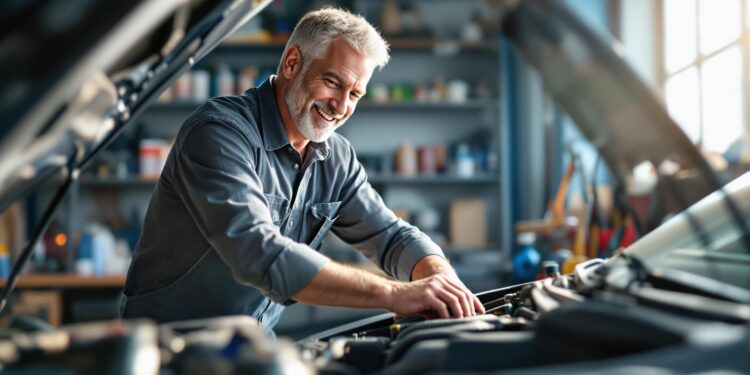Maintaining a used car doesn’t have to drain your wallet. Here’s how you can cut costs while keeping your vehicle in top shape:
- Stick to regular maintenance: Avoid skipping oil changes (costing $35-$125) to prevent expensive engine repairs (up to $5,000).
- DIY simple tasks: Replace air filters, check tire pressure, and clean battery terminals at home to save on labor costs.
- Compare repair services: Independent shops in Uganda charge 30% less than dealerships. Always get itemized quotes and negotiate for better deals.
- Use quality parts: Choose OEM or high-quality aftermarket parts to avoid frequent replacements and save up to 50% on repair costs.
- Boost fuel efficiency: Properly inflate tires, replace clogged air filters, and drive smoothly to save on fuel and reduce wear.
- Learn basic diagnostics: Tools like OBD scanners and multimeters help detect issues early, saving an average of $1,200 annually.
5 Ways to Save Money on Car Maintenance
Regular Maintenance to Avoid Expensive Repairs
Taking care of your car regularly is the smartest way to avoid costly breakdowns, especially with used vehicles. Setting aside at least $50 each month for maintenance and unexpected fixes can help you stay on top of expenses [4].
Stick to the Manufacturer’s Maintenance Schedule
Following the service schedule recommended by your car’s manufacturer keeps it running well and helps you avoid expensive repairs. In Uganda, where parts and repairs can be pricey, sticking to this schedule is especially important. For example, a basic oil change might cost between $35 and $125, but skipping it could lead to engine repairs costing as much as $5,000 [4].
| Maintenance Task | Cost Range |
|---|---|
| Oil Change | $35-$125 |
| Tire Rotation | $20-$50 |
| Brake Service | $100-$200 |
Handle Simple Maintenance at Home
You don’t need to rely on a mechanic for everything. Tackling a few basic tasks yourself can save money and keep your car in better shape. Here are a few things you can do:
- Replace air filters to cut out labor costs.
- Check tire pressure regularly to ensure even wear and improve fuel efficiency.
- Clean battery terminals to avoid starting problems.
Keep Detailed Maintenance Records
Document every service, including dates, mileage, replaced parts, and any unusual issues. This helps you identify patterns, catch problems early, and even maintain your car’s resale value.
"Waiting too long between mechanic visits lets minor problems escalate into big ones." – Bumper Blog [1]
Small habits, like regular cleaning and careful driving, also go a long way in reducing wear and tear. By staying consistent with maintenance, you can avoid major repairs and keep your car running longer.
Finding Affordable and Reliable Repair Services
In Uganda, getting your car repaired without overpaying can be a challenge, especially with limited access to specialized tools and parts. According to the Automotive Service Association, independent repair shops often charge 30% less than dealerships for routine services [1].
Why the difference? Independent shops tend to have lower labor rates and more flexible pricing structures, while dealerships rely on factory-trained technicians and exclusive tools. For instance, a local repair shop might charge 44% less than a dealership for brake repairs [2].
How to Compare Repair Services in Uganda
AutoMag.ug recommends looking for mechanics who offer:
- Proper certifications and training from recognized institutions
- Well-equipped workshops with advanced diagnostic tools
- Clear pricing policies with detailed, written estimates
Take Kamalesh Auto Works in Kampala as an example. With a 4.9-star rating from 97 reviews, it’s a trusted option for many local drivers.
According to the Federal Trade Commission, comparing prices can save you an average of 15% on repair bills [2]. To get the best deal, request itemized quotes, ask about warranties, and confirm diagnostic fees upfront. A written estimate not only helps you negotiate but also avoids surprise costs. The Consumer Federation of America found that negotiating with competing quotes can save an additional 10% on average [2].
After finding a trustworthy repair shop, focus on selecting high-quality replacement parts to keep your car running smoothly for years to come.
sbb-itb-7bab64a
Choosing Durable and Reliable Replacement Parts
Using long-lasting replacement parts not only keeps your car running smoothly but also cuts down on repair expenses over time. In fact, Consumer Reports highlights that high-quality parts can help car owners save up to 50% on repair costs by reducing how often replacements are needed [6].
Compare OEM and Aftermarket Parts
Deciding between Original Equipment Manufacturer (OEM) and aftermarket parts comes down to understanding their differences:
| Feature | OEM Parts | Aftermarket Parts |
|---|---|---|
| Cost | 30-60% higher | Often 30-40% cheaper |
| Quality | Consistent, factory-standard | Varies by manufacturer |
| Warranty & Availability | Full manufacturer coverage but may take weeks | Limited warranties, usually immediate |
Where to Buy Good Quality Parts in Uganda
For reliable parts in Uganda, consider trusted suppliers like Daystar Auto Parts Limited and Wycliffe Emmanuel Motors Limited in Kampala. These vendors are known for providing genuine parts, ensuring quality and offering warranty options.
"Always buy genuine parts to ensure peak performance and reliability for your vehicle", says Emmanuel Muyombya, a spare parts dealer at Wycliffe Emmanuel Motors Limited. "Cheaper parts end up costing more in the long run since they wear out faster and need frequent replacements."
Avoid Using Low-Quality Parts
Using low-grade parts can lead to higher risks and expenses. According to AAA, substandard components increase the chance of accidents by 30% [3]. To avoid these risks:
- Inspect parts for proper branding
- Look for recognized quality certifications
- Review warranty terms
For critical safety components, choose OEM or high-quality aftermarket parts. While they might cost more upfront, their durability and reliability save money in the long run.
Once you’ve secured dependable parts, the next step is identifying potential issues early to prevent unnecessary expenses.
Learn Basic Car Diagnostics to Save Money
Learning how to diagnose basic car issues can help you cut down on maintenance expenses. In fact, Consumer Reports found that drivers who regularly check their own vehicles save an average of $1,200 a year on repairs compared to those who don’t [5].
Essential Tools for At-Home Diagnostics
You don’t need a mechanic for every issue. With a few basic tools, you can identify problems early and avoid expensive repairs. Consider getting:
- OBD scanner ($50–$200): Reads error codes from your car’s system.
- Multimeter ($30–$80): Measures electrical issues.
- Pressure gauge ($15–$40): Checks tire or engine pressure.
"A basic OBD scanner can alert you to problems before they cause major damage, potentially saving thousands in repair costs" [5].
Watch for Common Warning Signs
Catching issues early can save you both time and money. Keep an eye (and ear) out for:
- Dashboard warning lights – don’t ignore them.
- Strange sounds when braking, accelerating, or turning.
- Fluid leaks under the car – these often signal bigger problems.
Addressing these signs quickly can stop minor problems from escalating into costly repairs.
Decide When to DIY or Call a Mechanic
Some tasks, like oil changes or tire rotations, are simple enough to do yourself. But for more complex systems – like engines, transmissions, or brakes – it’s best to leave the work to a professional. This way, you save money without compromising safety.
For those in Uganda, AutoMag.ug suggests building a relationship with certified mechanics. They can guide you on trickier issues while supporting your DIY efforts.
Save Money by Improving Fuel Efficiency
Boosting your car’s fuel efficiency can cut down on operating expenses in a big way. The American Automobile Association (AAA) estimates that fuel-efficient driving saves the average driver $1,200 annually on gas costs alone [4].
Smart Driving Habits to Cut Fuel Costs
Did you know aggressive driving can slash your fuel economy by up to 33% on highways and 5% in the city [2]? Driving smoothly – avoiding sudden stops, harsh acceleration, and long idling – can make a big difference. Another easy tip? Clear out unnecessary weight from your car to improve efficiency even more.
Simple Maintenance for Better Mileage
Routine maintenance can have a noticeable impact on your car’s fuel economy. Here’s a breakdown of key tasks and how much they can help:
| Maintenance Task | Potential Fuel Savings |
|---|---|
| Keeping tires properly inflated | Up to 3% |
| Regular engine tune-ups | About 4% |
| Replacing a clogged air filter | Up to 20% |
"Properly maintaining your vehicle can improve fuel efficiency, reduce emissions, and save you money." – U.S. Department of Energy [1]
Choosing the Right Fuel
Stick to the fuel grade recommended in your owner’s manual. Using premium gas in cars designed for regular won’t give you any extra performance or efficiency. In Uganda, AutoMag.ug advises drivers to monitor prices and buy fuel from trusted stations known for quality.
Using fuel efficiently not only reduces wear on your engine but also means fewer repairs and lower maintenance bills over time. By focusing on fuel efficiency, you’re not just saving money now – you’re also extending your car’s life and setting yourself up for long-term savings.
Conclusion: Steps to Save on Used Car Maintenance
Keeping a used car in good shape doesn’t have to break the bank. With the right maintenance habits, you can avoid unnecessary expenses and keep your vehicle running smoothly. This is especially important in Uganda, where car repairs and spare parts can be pricey.
Simple habits like checking fluids and tire pressure regularly can help you avoid expensive repairs down the line. By focusing on prevention, you can ensure your car stays dependable without overspending. In Uganda, it’s also wise to compare repair shop prices and maintain detailed records to guarantee quality work and even improve resale value.
Here’s what matters most when it comes to maintaining a used car:
- Stick to preventive maintenance: Regular check-ups go a long way.
- Use quality parts and services: They reduce the risk of breakdowns.
- Catch problems early: Address small issues before they grow.
- Shop smart: Compare prices to get the best value.
- Keep records: They’re useful for tracking work and boosting resale value.
AutoMag.ug highlights the importance of finding trustworthy mechanics and sticking to a consistent service schedule. This is especially useful in Uganda, where the automotive market presents unique challenges.
Related Blog Posts
- SUV vs Sedan: Best Choice for Ugandan Roads
- 8 Essential Car Maintenance Tips for Uganda’s Climate
- Used Car Inspection: 10-Point Checklist Before Buying
- Common Car Problems in Uganda: Solutions Guide




